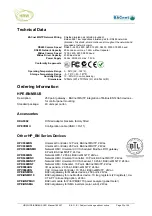
HRW HPE-BNMBUS V401 Manual 180307 E. & O. E. / Subject to change without notice
Page 21 of 24
The RS485 cable should avoid cable routes that run with power cables. Where the RS485
cable must cross power cables then they should cross at 90° avoiding parallel runs beside
power cables
Prior to connection of the slave devices to the RS485 network check that no AC voltage is
present. Double check the network for short circuits between the twisted pair cores and
between the cores and the screen. Ensure continuity of the twisted pair cores and the screen
Check the network master’s +/- terminals for correct voltages to ground (approx. 2.5Vdc) and
connect the RS485 network cable to the network master’s RS485 port
At each device assign an individual address and the baud rate specific to the network. Write the
changes, eXit the terminal application and remove the HPECOM cable
Verify network voltage at the RS485 connector (b/- and ground) and connect to the
device. Communication can be verified by flashing of the red comms LED adjacent the 3
terminal RS485 connector). Frequency of comms LED flash is baud rate dependant. At higher
baud rates the LED flash may not be obvious, the LED appearing to be continuously on
Where a network runs between buildings and zero earth potential difference between individual
panel 24Vac power supplies cannot be guaranteed, we recommend that a repeater be used to
provide isolation of the sections of the network having differing earth potential
M-Bus
Pre April 2010 hardware versions:
To avoid damage to the M-Bus communication drive chip
always ensure that there are no short-circuits on the M-Bus network before connecting to the
M-Bus port and applying power. When it is confirmed that the M-Bus is free of shorts you may
connect the 24Vac supply (devices after April 2010 include short-circuit protection on the M-Bus
port).
After connection of the supply check that the voltage at the M-Bus terminals is approximately
36Vdc
Please contact us for M-Bus wiring recommendations




































